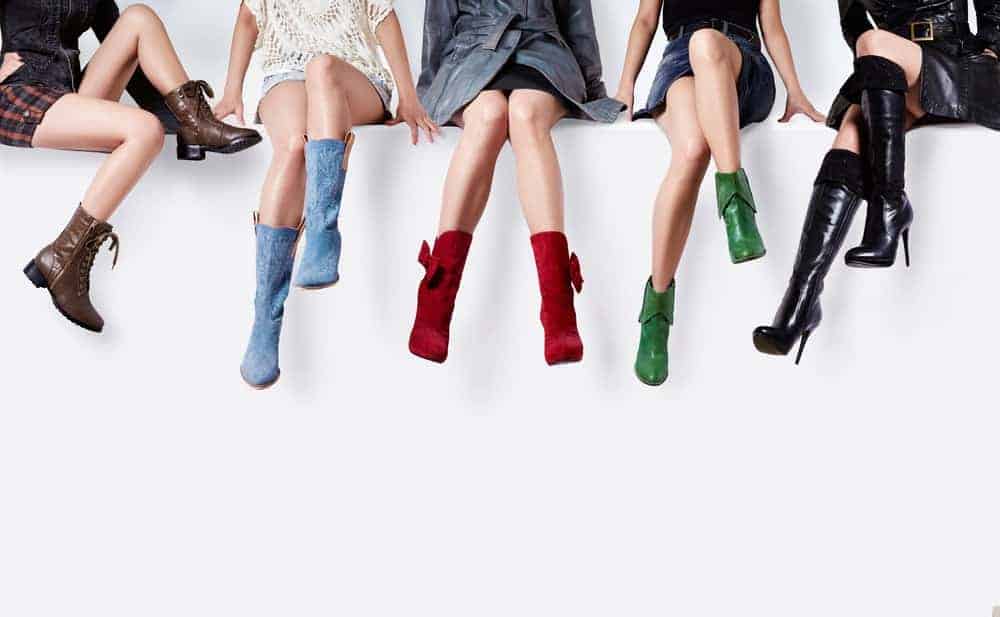Hiking is a wonderful activity that can provide hours of entertainment with friends. Finding the right hiking boot, style, and available performance features needed for your particular hiking needs can make all the difference when it comes to performance, durability, and comfort throughout your hike in the wild outdoors.
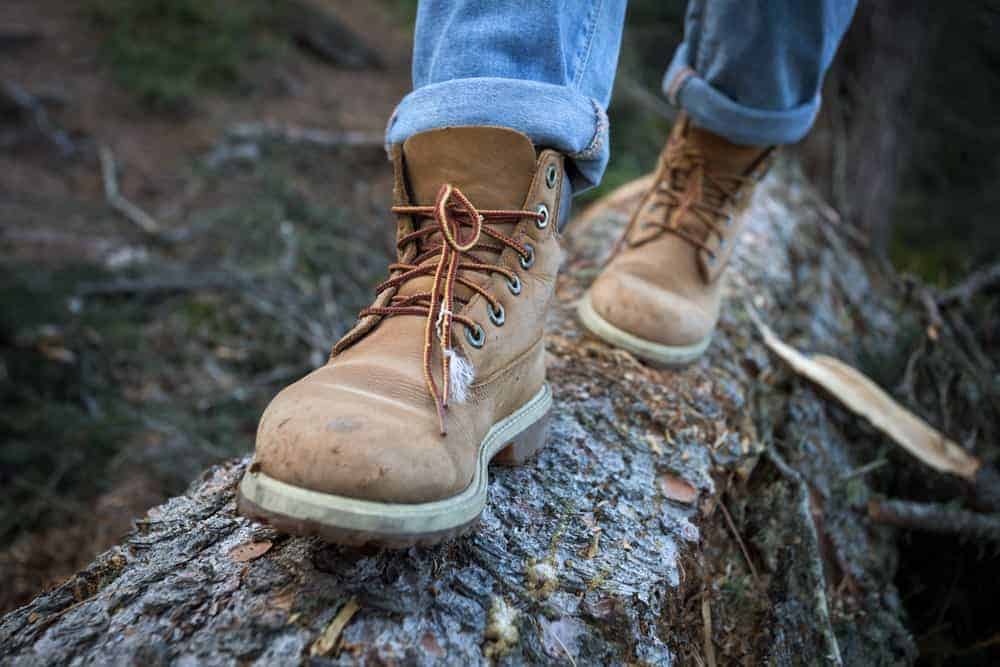
Absolutely nothing is better than spending a day outdoors hiking. You can become one with nature, get some exercise, and possibly enjoy some time with friends. Whether you are interested in a short and casual hike or a multiple-day trek through the forest, having the right footwear is essential.
Hiking boots come in many shapes, styles, and designs with various features intended to help keep you comfortable on your hike. Below, let’s take a closer look at the several types of hiking boots to highlight the pros and cons of each, as well as their intended use.
Types of Hiking Footwear (Shoes and Boots)
Day Hiking Boot
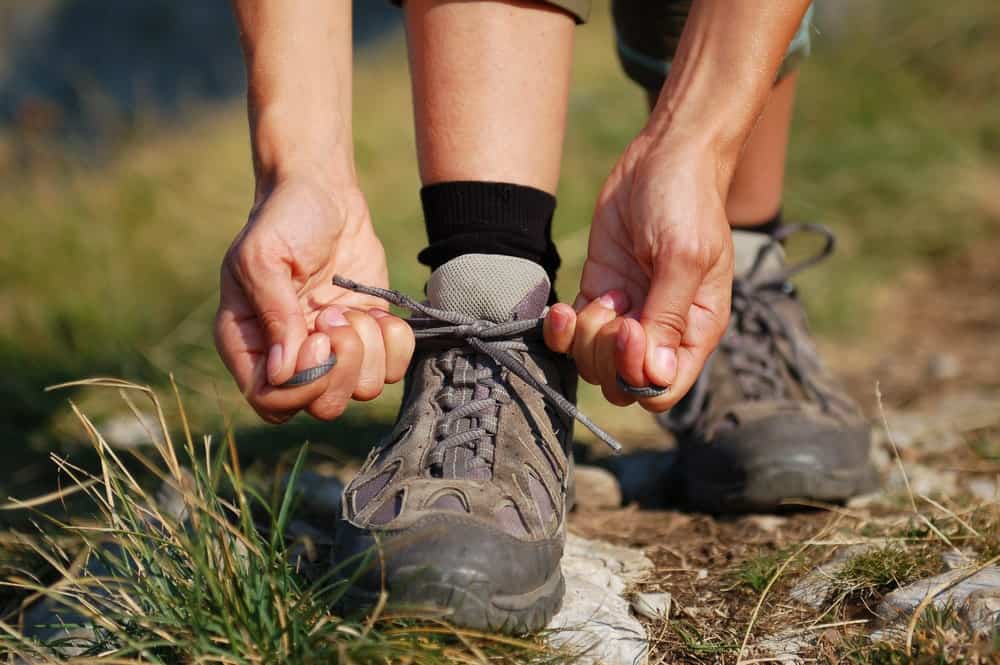
For those who enjoy a good hike during the day, under 10 miles, a day hiking boot is perfect. These boots are a wonderful blend of the necessary traction and comfort traditional hiking boots can provide, with the ongoing comfort and flexibility often felt in sneakers or running shoes. When shopping for day hiking boots, be careful to fully research the shoe’s intended use before committing to your purchase.
A day hiking boot should provide enough traction for you to make it through varying terrain and conditions throughout your hike. Make sure the sole of the boot is sturdy and rigid. When hiking, you may encounter mud, rocks, water, or snow and ice, which can make finding sturdy footing paramount. Be sure to pay close attention to the material used to make the sole of the boot. Materials such as a Vibram sole are puncture-proof, able to protect the feet.
Next, when choosing a day hiking boot, be sure to pay close attention to the height of the boot itself. Some day hiking boots, like the ever-popular Merrell Moab, will hit just below the ankle. This allows improved flexibility for walking over uneven terrain or rocks. The Merrell Moab features a rigid construction through the ankle that still gives you the support you need. Other day hiking boots are cut lower, though, mimicking the outline of a traditional sneaker. These may be more comfortable for some people but will not provide the stability needed to complete long-haul day hikes.
Lastly, look at the material of the day hiking boot. Some boots are made with waterproof materials to help protect the feet as you hike through streams and puddles. The Merrell Moab boot comes in a waterproof variant that can keep your feet dry for hours of hiking. The downside of waterproof materials is that they can become hot. For those that are hiking in dry terrain, consider a day hiking boot that is breathable, with plenty of mesh material panels to allow air to circulate, keeping your feet nice and cool through miles of hiking.
If you are a novice hiker or limit your mileage day to day, a day hiking boot may be perfect. These shoes are often moderately priced but can provide years of strong wear and use. The limited stability and rigidity can help make these hiking shoes more comfortable for people not quite ready to commit to several days, or miles, of hiking.
Plus, hiking shoes are great for all seasons and often offer some protection from water and the weather with insulation, waterproof materials, and additional padding. Remember too, that a hiking shoe is only as good as the hiking socks you are wearing with your boots. Invest in a good quality pair of hiking socks made of natural materials to help keep your hiking boots comfortable for a full day of hiking.
Backpacking Boot
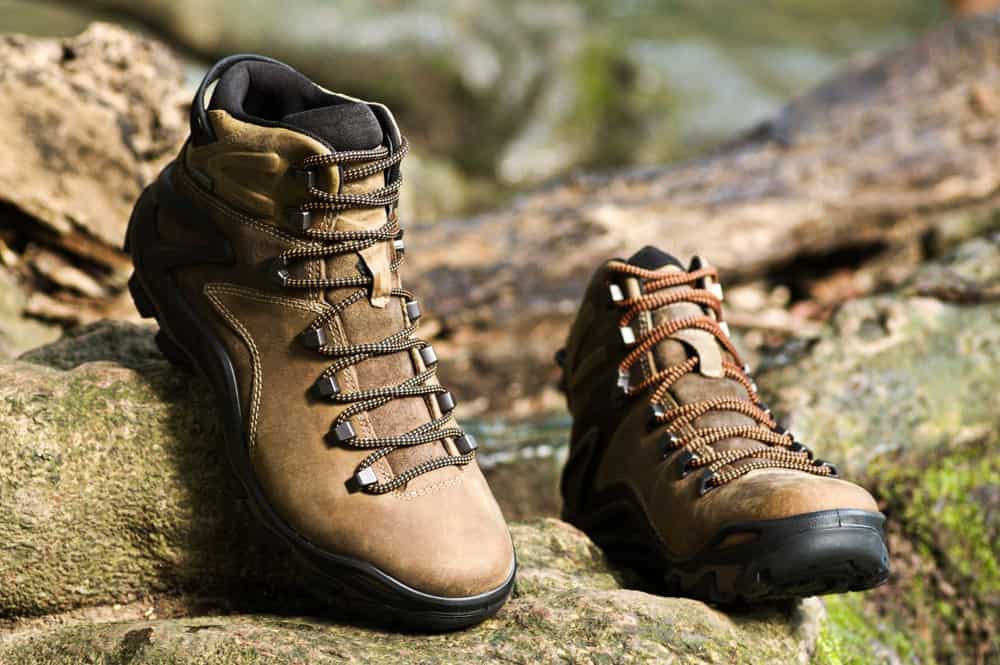
Sometimes called a trekking shoe, a backpacking boot is designed for people who plan on hiking with a heavy backpack for multiple days. Although this type of boot may look similar to other hiking boot varieties, a backpacking boot has several design features that make it ideal for backpacking.
This boot typically fits higher around the ankle and often has several speed laces near the ankle to tie the laces. Added ankle support is vital when hiking with a heavy pack on your back. Not only will this help to give you more strength in your legs to carry a heavy load, but a higher ankle can give you more stability when walking over uneven terrain and projecting rocks. A high ankle is a necessary feature when searching for a suitable backpacking boot.
Next, these shoes usually have a special sole designed to help absorb impact as you walk. Hiking with a heavy pack can put a load of extra weight and stress on your joints, making it uncomfortable to carry your weight for a long distance.
Trekking shoes are specially designed with soles that can help balance and transfer the impact throughout the shoe. Many people prefer an Eva midsole. This is the type of sole commonly used in running shoes that can help to absorb repeated impact. This means that these shoes are comfortable to wear when hiking for long hours during the day.
Like any other hiking boot or shoe, backpacking boots are available with many desirable features for hikers. Depending on your personal preference, it is possible to get these shoes in different materials, including leather and synthetic productions. These shoes have varying cushioning, padding, and insulation levels to provide just the right amount of support for your main function while hiking.
Further, these shoes can feature different mesh material inserts, improving breathability and adding improved airflow and circulation to the feet. Remember, hiking with a heavy pack for several miles can be painful even with even the best shoes. Be sure to wear appropriate hiking socks made of a natural material like wool to keep your feet protected and cushioned from possible painful blisters.
Trail Shoe

A nice shoe option between a hiking boot and a traditional running shoe is the trail shoe. This is a type of tennis shoe style that is made to endure varying terrain. Many people enjoy wearing a trail shoes compared to traditional hiking boots if they are going on short to mid-length hikes. A trail shoe is a wonderful option for hiking footwear that is versatile, comfortable, and flexible.
A trail shoe often hits below the ankle and laces up just the way a typical sneaker or running shoe would. Trail shoes offer plenty of flexibility and mobility around the ankle, which feels less restrictive than high laced ankle boots. While this gives people added comfort and more flexibility, it can compromise stability. For long hikes and backpacking, a trail shoe is not the best hiking shoe for the job.
Trail shoes often come in a range of materials and can include both natural and synthetic fibers. Hiking shoes of this type can be found in leather or in synthetics that feature rubber and plastics. The trail shoe often has comfort features such as added cushioning in the heel, additional padding at the front of the foot base, and flexible stitching to provide an optimum range of motion.
Like other hiking footwear options, trail shoes can offer attractive features to hikers moving through varied terrain. It is possible to find waterproof trail shoes or trail shoes that feature added insulation to keep hikers warm. Trail shoes can be made with a puncture-proof Vibram sole that can protect the foot against sharp rocks and protruding roots that can be harmful.
While many people prefer a trail shoe to hiking footwear alternatives, the trail shoe does have some limitations. The lower profile often limits the amount of stability provided by the shoe. Further, although this shoe is available in a waterproof design, there is the distinct possibility that water can easily pour over the top of this shoe due to its low profile. Lastly, this option for hiking footwear does not help protect the ankles from possible rolls as you walk over uneven ground.
Many of the major outdoor companies and manufacturers will carry a style of trail hiking shoe. These include Merrill, Keen, and Salomon. If you are an avid hiker, it may be a good idea to own a pair of hiking shoes separate from your hiking boots. This will give you a lightweight and comfortable hiking footwear option for shorter and less difficult hikes. Many hiking shoes are made with lightweight materials that are flexible and breathable.
Waterproof Shoe

Because of the constantly changing conditions that you may experience on the trail, it is a good idea to invest in a waterproof shoe. Having wet feet for a trail is miserable, but wearing the wrong hiking footwear can lead to painful blisters and infection potential. Finding the right hiking boot that is insulated and waterproof should help alleviate some common hiking complaints.
Please note there is a difference between water-resistant shoes and waterproof shoes. Water-resistant shoes are intended to help repel water keeping your feet dryer compared to traditional leather or synthetic material shoes.
Water-resistant boots will certainly help to keep your feet dry but won’t offer much protection after extended wear through the water or if your foot becomes completely submerged. Water-resistant boots are often less expensive than their counterpart. Further, water-resistant boots can often have their protective layer reapplied at home. This is a good practice to make sure water continues to wick away even after years of use.
Alternatively, waterproof shoes for your hiking footwear provide a layer of material outside your boot that water cannot penetrate. A common waterproof material is Gortex, which is flexible and breathable. Gortex boots will cost more but will provide better protection from the elements.
While waterproof shoes do help to keep moisture out of your boots, keep in mind that, at times, they can also keep water in your boots. If your boots have water pour over the top of them from a deep stream or puddle, remember that letting water escape from waterproof boots may be a challenge.
Mountaineering Boot
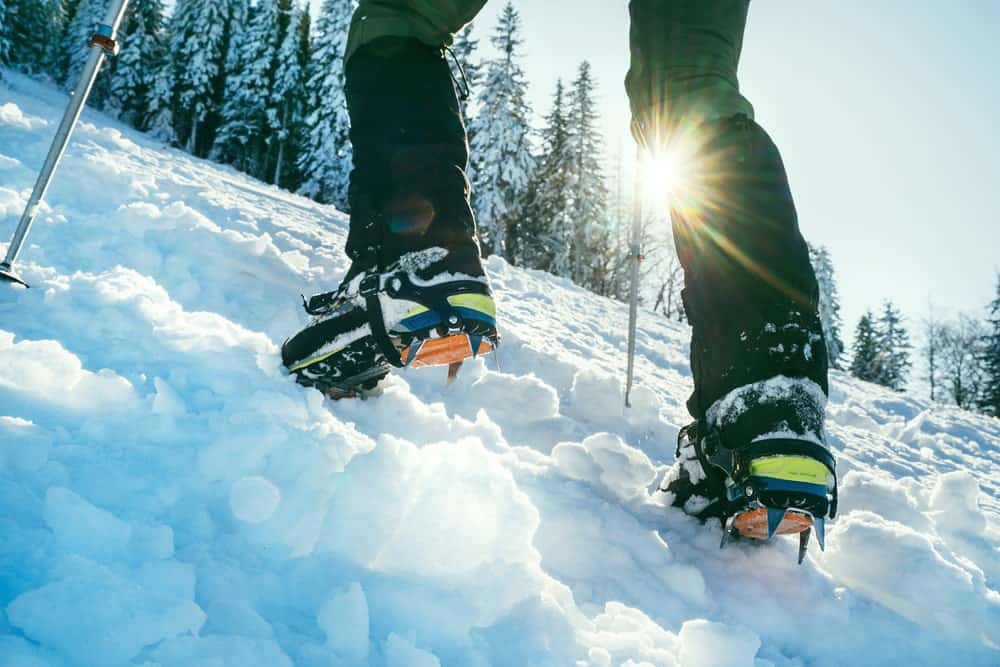
Different from a hiking boot, a mountaineering boot has a particular and intended purpose. While a hiking boot is intended for hiking activities such as hiking through a forest, a mountaineering boot is intended for people who hike or climb mountains. These boots are usually designed to protect the feet and ankles while providing structure, warmth, and durability when crossing snow and potentially icy glaciers. Mountaineering boots look different from hiking boots and are made with different materials.
The first key difference with a mountaineering boot is the material that is used for construction. Usually, the parts of a hiking boot made with thin mesh fabrics intended to improve breathability are replaced with strong and rigid materials to add stability and increase the waterproofing qualities. Often, mountaineering boots will have more leather, plastic, or Kevlar added to the boot.
These boots are designed with more rigid materials intended to keep the boot sturdy rather than allow the boot to bend. Mountaineering boots will usually feature added insulation and padding to protect you during colder weather conditions typically found in the mountains.
The style of the boot is also slightly different from a hiking boot. While the overall shape may be the same, many mountaineering boots are designed to fit over the ankle with a sturdy and rigid shape. The style usually appears thicker and more robust than a hiking shoe.
Often, this design feature is most apparent in the heel or the toe of the boot. The heel is often reinforced with thick plastic to add durability, and the rounded toe has extra protection to keep the feet warm and protected. Further, when flexed, a mountaineering boot is typically much stiffer.
Lastly, the main difference between a mountaineering boot and a hiking boot is the intended use. Mountaineering boots are designed for people who are climbing mountains in difficult conditions. If mountaineering boots are worn for a day hike, the wearer may be disappointed in the performance.
These boots are particular with their design and purpose and often suit a niche market. If you are a mountaineer, be sure to read about each boot available to learn about the specifications. Some boots are intended for extremely frigid conditions, while others are designed for stability and durability. Compared to other hiking shoes and boots on our list, mountaineering boots will be the most expensive, often featuring high-end features and construction.
Hiking Sandal
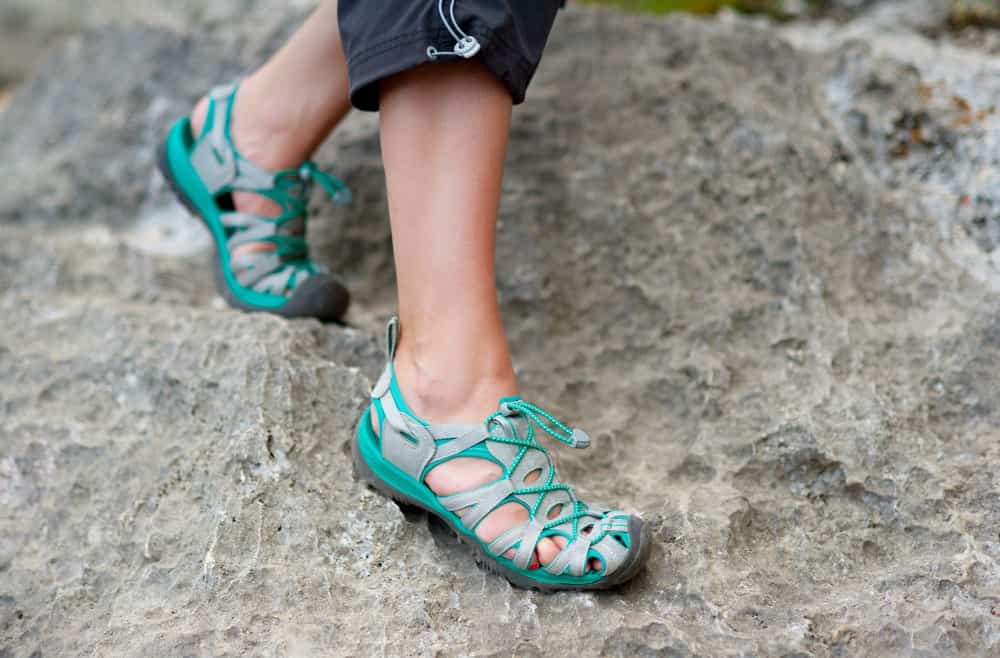
Sometimes, a gentle hike on a summer day just calls for a hiking sandal. This hiking shoe option is ideal for people who want to be outdoors but don’t need a vigorous or challenging hike to connect and be one with nature. Although this is not one of the more durable hiking footwear options, it is a comfortable and breathable solution perfect for short summer hiking.
The hiking sandal is first and foremost a sandal. This shoe is intended to be lightweight and breathable, which allows for plenty of airflow and circulation. A hiking sandal can be as simple as a few straps across the foot or as detailed as a traditional shoe form, with big holes cut into the design to allow optimum airflow.
While a sandal does not strike most people as a suitable hiking shoe, these sandals are made especially with hikers and avid outdoors people in mind. The hiking sandal is made with a durable sole that is both puncture-proof and sure to give you plenty of traction.
Many hiking sandal options have a rugged sole with added grip and traction, helping you navigate a range of terrain conditions. The sole is often made of a puncture-proof material that can help protect the feet’ bottom from sharp rocks, sticks, and roots protruding up from the ground.
Often, hiking sandals will feature one of two designs. In one design, the toes are left open and exposed, similar to a common, everyday sandal. These shoes feature two to three straps across the foot to keep the sandal in place. While these shoes are ideal for mild hikes and stroll through waterways, they may not be the most protective hiking footwear option.
The other version of the hiking sandal features a cap, usually made of rubber, that encloses the toes. This is a preferred design by many people because it gives an added layer of protection not to stab your toe while hiking. The added toe protection is a great way to stave off injury while hiking on rough terrain. Of course, having the toes enclosed does limit the amount of airflow circulation in the shoe.
Like other hiking shoe options, the hiking sandal is made of various natural and synthetic materials. It is possible to find the hiking sandal in leather, plastic, Gortex, or some combination of the three. Hiking sandals are generally at a mid-range price point and have their limitations when hiking on the trail. Be sure to only wear hiking sandals for short, leisurely walks, and make sure you check the terrain before venturing out on a multi-mile hike while wearing hiking sandals.
Trail Runner
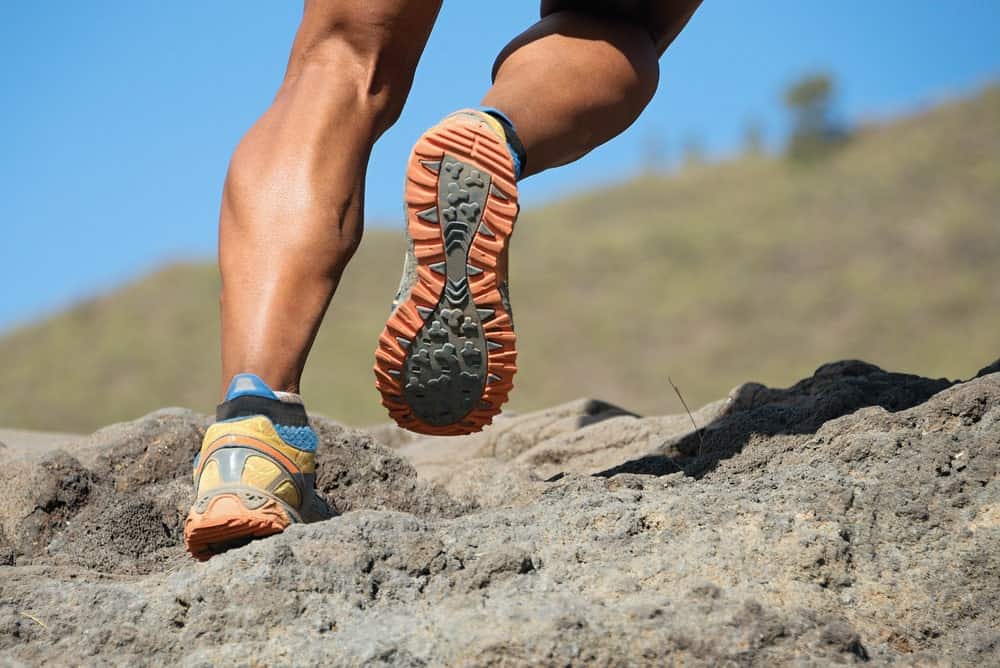
Probably the furthest thing on our list from a hiking boot is the trail runner shoe. This is basically a tennis shoe or sneaker that is intended for trail running. The trail runner shoe is perfect for people who like cross country running or who just want a versatile shoe that can be worn for hiking or everyday wear.
The trail runner looks and feels just like a tennis shoe. Often, major companies and brands that produce running shoes such as Adidas, Nike, and Brooks, will also feature a trail runner option. This utilizes the same construction techniques and materials as a traditional running shoe but offers added protection for the sole.
Because many trails feature sharp rocks, sticks, and roots jutting out on the trail, these shoes’ sole is made with added traction. That means the sole will have more texture and dimension, intended to grip the ground as you run.
The trail runner sole will also usually be constructed of puncture-proof materials to help further protect the feet. Expect the shoe’s sole to extend up and onto the sides of the shoe to give added traction when you run or bounce off of varying terrain.
This type of hiking shoe will provide the most amount of flexibility. A trail running shoe is designed to move and flex with the varying terrain, allowing the person to glide over the ground. These shoes are made of lightweight materials, so they are comfortable and easy to run in. Expect these shoes to fit and feel almost identical to a traditional running shoe, with some offering slightly more support in the sole.
While this is certainly a great and comfortable shoe for running cross country in the forest, it will not be a great hiking option. These shoes are often flexible, but so flexible in a way that does not offer the support needed to withstand a multiple mile hike.
These shoes rarely come in a waterproof design because the shoe intends to be breathable, offering plenty of airflow to the feet as you run the trails. Further, this shoe offers little to no ankle support, so wearing these shoes for serious hikes, especially over rough terrain, runs the risk of turning or rolling an ankle.
Lightweight Hiking Boot
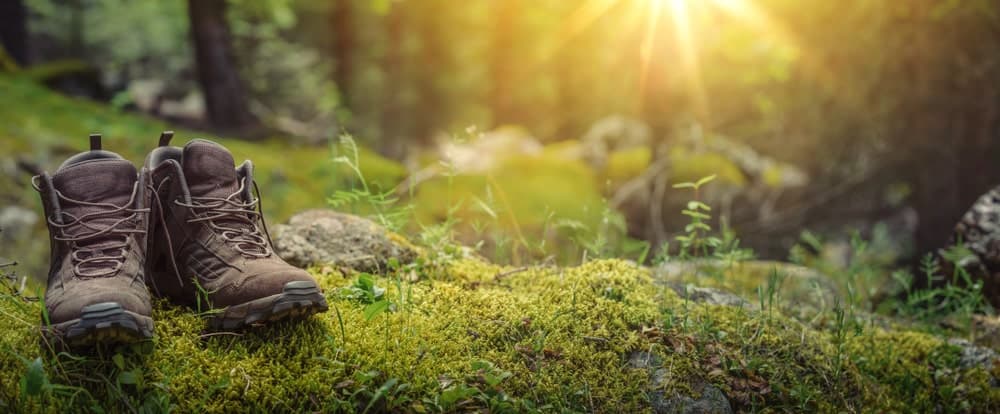
For many, the only important feature when choosing a hiking boot is finding a lightweight hiking boot. This is essential for people covering miles of terrain or carrying an extra pair of boots in their pack. Lightweight boots are made of materials that expertly balance the durability and stability required, with minimal weight to drag around all day on a multi-mile hike.
If you are looking for a lightweight boot, consider the overall construction. Often, boots that are made with human-made materials are lighter than natural materials. Lightweight boots can feature all the same design elements that make other boots attractive. You can find a waterproof boot that is also lightweight, as well as a stability boot that weighs less than two pounds.
Just because a boot is made of lightweight materials does not mean you have to jeopardize performance. It is perfectly possible to find a lightweight boot to use for backpacking that is still durable, supportive, and flexible.
Often, many of the materials used in backpacking shoes are made with weight in mind. Expect to find several lightweight hiking boot options for both men and women under 2 pounds total. It is perfectly possible to find boots that are around 1.5 pounds if you look carefully and specifically for boots intended to lighten your load on a long hike.
Barefoot Shoes

For those of us that want to feel the earth beneath our feet as we hike, barefoot hiking is not always feasible or safe, for that matter. The next best thing to hiking barefoot is to wear barefoot shoes. This lightweight hiking shoe is the perfect way to minimize the amount of material and support wrapped around your foot. Barefoot shoes are growing in popularity and can provide a completely different hiking experience.
Offered by several manufacturers, the leading barefoot shoe designer is Vibram. Their puncture-proof and durable sole make this shoe incredibly durable and safe, even while hiking rocky terrain. With only a thin layer of Vibram protecting the wearer from the rocky terrain, Vibram guarantees that your feet will stay safe and well protected.
While the barefoot shoe does absolutely nothing to provide ankle support, this is a favorite shoe by many naturalists. The lightweight shoe allows people to gently glide over the forest floor, creating an as little impact on the environment as possible. Plus, many barefoot shoe designs feature a toe box that has individual toes. This keeps your feet and toes protected while still giving your toes room to spread out and grip to varying terrain.
One true advantage of this lightweight and thin hiking shoe is its performance in the water. The Vibram sole provides plenty of traction through streams and creeks while keeping your foot protected. Plus, the lightweight material these shoes are designed with allows for plenty of airflow and circulation. This means that your shoes and feet will dry incredibly quickly following a dunk in the water.
It should be noted that it takes time and practice to wear this shoe, especially for long distances. Between the minimalist design and the open toe box, a person can cause serious injury to their feet if they attempt a long hike wearing these shoes for the first time. It is best to build up the muscles in your feet and legs to withstand a barefoot hike before going out for a multiple-mile hike. This shoe is not recommended for extremely rugged terrain or backpacking.
FAQs
So you’re ready to go out in the wilderness and explore the world around you. Great! The first step is narrowing down the right pair of hiking boots for you. Do you need a waterproof hiking shoe or a solid leather boot? It seems the options are overwhelming, with many hiking shoes offering different features and styles. Below, we put together a list of the most commonly asked questions surrounding hiking boots to get you pointed in the right direction.
What are the different types of hiking boots?
Because there are many types of hiking adventures and people, there are many types of hiking boots. All hiking boots are designed with a specific purpose in mind. Some hiking boots, such as mountaineering hiking boots and trekking hiking boots, are intended for multiple miles, over several days, with rugged terrain. These boots will often have special features such as a stiff sole or waterproof material to help keep the boots comfortable.
Other hiking boots, such as hiking shoes and hiking sandals, are intended for shorter hiking adventures that may extend up to 10 miles in one day. These shoes are designed more for comfort and flexibility to keep your feet and ankles comfortable for short to medium-length hikes.
Further, there are still specialty hiking shoes such as a minimalist shoe for hiking, trail runners, and lightweight hiking boots. These hiking shoes cater to a specific group of hikers with a particular goal in mind. To some, having the freedom to feel the Earth under their feet is most important, while to others having boots with the lightest weight possible is most important. Before choosing the best hiking boot for you, think about the intended purpose and the proposed terrain.
What type of shoes or boots do you need for hiking?
That all depends on the type of hiking, you plan on doing! If you are a novice hiker, research the available trails around your house and think about your current fitness level. Do you plan on just hiking a few miles a day through fairly mild terrain? If that is the case, a lightweight hiking shoe or a day hiking shoe might be the best option.
If you are an avid hiker and want to backpack to new locations, you may want to look for a shoe specific to backpacking. These hiking boots are often designed with a sturdy sole that can absorb some of the additional weight that comes with carrying a heavy backpack.
To all the cross country fans out there who plan on running through the forest, a lightweight trail runner may be the best option. This allows you to spend time in nature still running a trail but gives you the flexibility and breathability you would come to expect from a traditional running shoe or sneaker.
For the serious adventurers considering climbing a mountain, a more sturdy shoe such as a mountaineering boot may be necessary. These boots are sturdy and built for stability, keeping your toes, feet, and ankles safe. Plus, these boots have additional insulation and added protection to keep your feet warm when hiking on glaciers and through feet of snow.
Should you get hiking boots or trail runners?
Really, the answer to this question comes down to your intentions on the trail. If you want to jog the trail and go for a short milage hike, a trail runner is probably the right option for you. For those that want to hit the trail and cover 10 miles in a day or more, sometimes while carrying a backpack, a traditional hiking boot may be the better option.
How should hiking boots fit?
Finding the right fit for your hiking boot makes all the difference. If your feet are unhappy on a walk, you will be unhappy. Keep your feet happy, and you will have a much more enjoyable experience. The number one key to fitting a hiking boot correctly is to ensure that the boot fits snug to the foot. When the boot is properly laced, there should not be any sliding.
This means your foot shouldn’t slide from front to back, and your heel should not slip out of the back of the boot. Hiking requires plenty of movement over uneven terrain. If your boot is slipping, it will cause painful blisters that can put even the toughest hiker out of commission.
Next, make sure you have plenty of room in the toe box. Unlike your everyday shoes, you want to make sure you have plenty of room at the front of your boot. As you hike, your feet will swell, and varying terrain can make your boot flex in different ways. If your boots are too small and rub against your toes, your toes and toenails will have a rough day of hiking.
Make sure that your toe box has plenty of wiggle room. It is important to always try your boots on with the type of hiking socks you plan on wearing. Some socks are thicker than others and can greatly impact the way your boots fit on your feet. Of course, any areas that are pinching your feet or rubbing your feet should be addressed immediately to prevent ongoing hot spots when you hike.
Can you wear running shoes for hiking?
In a pinch, yes, a running shoe will be sufficient to get through a short hike. At least a running shoe will protect your foot from errant rocks, roots, and sticks. Long term, though, a running shoe is not going to be a good option for hiking.
Many hiking boots are designed to give you added stability and support as you hike through changing terrain. Many hiking boots are even laced up above the ankle to help give your ankles and legs more support when walking through rocky areas. A running shoe usually hits below the ankle, making it possible to roll or twist the ankle when walking on varied terrain.
Plus, most running shoes just don’t have the same kind of durability necessary to withstand a long day of hiking. Running shoes are often made out of lightweight materials that do not do a great job fighting off tears and punctures. Plus, running shoes rarely have the added features many hiking boots do, such as water-resistant or waterproof materials.
Lastly, running shoes do not offer support for your feet. If you plan on backpacking, stay away from running shoes. Backpacking puts a tremendous amount of additional weight and strain on your joints, which translates down to your feet. Having specially designed hiking boots that can help absorb this impact and weight means staying more comfortable on your hike. A running shoe will often turn to mush, squishing under the additional weight of a pack and providing little added protection for your hike.
Do you need waterproof hiking shoes?
There are many benefits to a waterproof shoe. Not only will these shoes help to keep your feet dry, but they can help to keep your feet warm too. Hiking with wet feet is the fastest way to ruin a day out in nature. Waterproof hiking shoes can help prevent rainwater and snow from penetrating the boot. Plus, your feet will stay dry as you hike through puddles and shallow streams.
The one downside to waterproof shoes is the very fact that water cannot pass through the boot. This is wonderful when you are trying to keep water out of your boot, but terrible if water gets into your boot. Many waterproof boots lack the breathability aspect, which prevents air from getting to your feet.
If water happens to breach the top of your boot from a deeper-than-anticipated stream, water can come flooding into your boots. Unfortunately, once water gets into a waterproof membrane on a shoe, it can be quite difficult to get water out of a waterproof boot. Consider this before purchasing boots with this feature.
What to look for when buying hiking shoes?
When buying hiking shoes, it is important to remember that everyone will have a different foot shape, so what works for one person may not work for another. Consider the fit for the specific type of shoe you are searching for above all else. It is important to wear hiking socks while you try on your hiking shoe.
Next, consider the construction of the hiking boot. Some hiking boots feature natural, breathable materials but may not offer the best protection. Other boots are designed with stability and excellent traction in mind and are ideal for rugged terrain and years of wear and tear. Other boots feature desirable design features like waterproofing, increased flexibility, or a stiff sole to absorb heavy impact.
Lastly, think about how you most often will use your hiking boots. If you require a heavy boot for miles of hiking, be sure to look into trekking boot options. For a mid-height boot that can withstand a medium-length hike, consider a day hiking boot option. Or, for people who simply want to get into the great outdoors and spend some time in nature, a trail shoe or a hiking sandal may be an ideal choice.
Where to Buy Hiking Boots
For many people, hiking boots are a big investment that will last for years with proper care. Purchasing a pair of hiking boots should never be taken lightly, so it is important to do your homework ahead of time to ensure you are buying quality, comfortable, and practical boots for your intended purpose.
If at all possible, try to buy hiking boots in person. Simply looking at a boot online or through a store window will not do anything for you. To be sure that a hiking boot is right for you, you must try the boot on with the sock you plan to wear for your hike.
Wear the hiking boots for several minutes through various activities. Walk around the store, climb the stairs, and do a jog. See how the boot feels and ensure that the boot is not slipping anywhere. Just because a hiking boot has great reviews does not mean it will be a good fit for you. Every person has a different foot shape and has different needs, so trying the boots on in person is essential.
If you have a local store that caters to outdoor adventures, seek their advice and help first. Finding a specialty store such as an R.E.I. or an Eastern Mountain Sports will do you a world of good. The team members that work at these stores are usually avid hikers themselves and know how to help and answer specific questions you may have. Sometimes finding a professional with the first-hand experience is worth its weight in gold when choosing hiking equipment.



